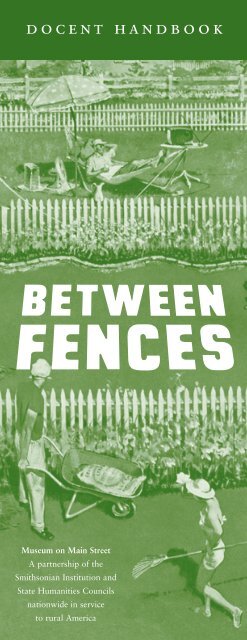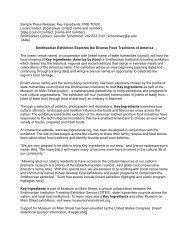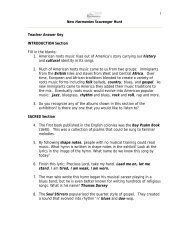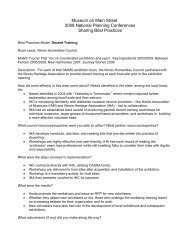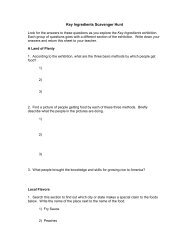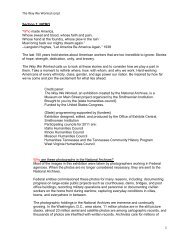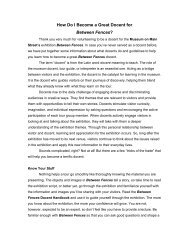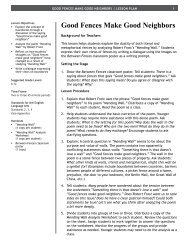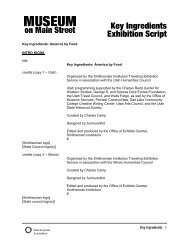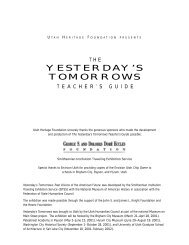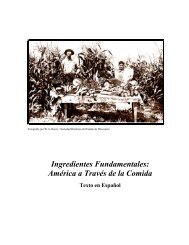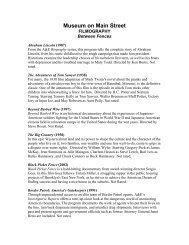Exhibition Docent Handbook - Museum on Main Street
Exhibition Docent Handbook - Museum on Main Street
Exhibition Docent Handbook - Museum on Main Street
- No tags were found...
Create successful ePaper yourself
Turn your PDF publications into a flip-book with our unique Google optimized e-Paper software.
docent handbook<str<strong>on</strong>g>Museum</str<strong>on</strong>g> <strong>on</strong> <strong>Main</strong> <strong>Street</strong>A partnership of theSmiths<strong>on</strong>ian Instituti<strong>on</strong> andState Humanities Councilsnati<strong>on</strong>wide in serviceto rural America
San Augustine County, Texas, 1939; Photo by Russell Lee.Library of C<strong>on</strong>gressCover: Detail of Spring Yardwork by Thornt<strong>on</strong> Utz,Saturday Evening Post cover, May 18, 1957; © 1957 SEPS:Curtis Publishing, Indianapolis, IndianaBETWEEN FENCES is a MUSEUM ON MAIN STREET exhibiti<strong>on</strong>developed by the Smiths<strong>on</strong>ian Instituti<strong>on</strong> Traveling<str<strong>on</strong>g>Exhibiti<strong>on</strong></str<strong>on</strong>g> Service.MUSEUM ON MAIN STREET is a partnership betweenthe Smiths<strong>on</strong>ian Instituti<strong>on</strong>, the Federati<strong>on</strong> of StateHumanities Councils, and state humanities councilsnati<strong>on</strong>wide that serves small-town museums andcitizens. This innovative project brings rural America<strong>on</strong>e-of-a-kind access to prestigious Smiths<strong>on</strong>ianexhibiti<strong>on</strong>s and first-rate educati<strong>on</strong>al humanitiesprograms. Most importantly, MUSEUM ON MAIN STREETenables rural museums to dem<strong>on</strong>strate theirenormous talents and their meaningful c<strong>on</strong>tributi<strong>on</strong>sto small-town life. Like all MUSEUM ON MAIN STREETexhibiti<strong>on</strong>s, BETWEEN FENCES was specificallydesigned to meet the needs of small instituti<strong>on</strong>s.BETWEEN FENCES was made possible through thegenerous support of the United States C<strong>on</strong>gress.For informati<strong>on</strong> about other MUSEUM ON MAIN STREETexhibiti<strong>on</strong>s, visit www.museum<strong>on</strong>mainstreet.org.
Welcome to BETWEEN FENCES and thankyou for being an exhibiti<strong>on</strong> docent/tourguide. We’ve created this handbook toincrease your familiarity with BETWEENFENCES and to assist you in helping visitorsappreciate and enjoy the exhibiti<strong>on</strong>.This handbook leads you through the exhibiti<strong>on</strong>secti<strong>on</strong> by secti<strong>on</strong>. It offers ideas, themes, andquesti<strong>on</strong>s designed to inspire meaningful discussi<strong>on</strong>during your tours. Your job as a docent/tour guideis to encourage visitors to think about the subjectand to invite them, through skillful questi<strong>on</strong>s,to share their own ideas and experiences.BETWEEN FENCES c<strong>on</strong>sists of an introducti<strong>on</strong>, fivec<strong>on</strong>tent secti<strong>on</strong>s, and a c<strong>on</strong>clusi<strong>on</strong>. This handbookfollows the same format. An overview paragraphfor each exhibiti<strong>on</strong> secti<strong>on</strong> or theme is followed by“Think About It” and “Let’s Talk.” “Think About It”helps you recognize important points in each secti<strong>on</strong>so that you can encourage your visitors to thinkabout them. “Let’s Talk” offers questi<strong>on</strong>s to askvisitors. Most are open-ended; the answers to otherscan be found in the exhibiti<strong>on</strong> text.Remember, you aren’t expected to be an expert curator.You’re here to open and lead a discussi<strong>on</strong>. Visitors whoarrive as part of an organized tour group usually feelmore comfortable speaking up. Visitors who arriveindividually and become part of a tour may requirea bit of coaxing. You d<strong>on</strong>’t have to ask all the questi<strong>on</strong>sin this handbook; just <strong>on</strong>e questi<strong>on</strong> can spark ananimated discussi<strong>on</strong>. You’ll quickly learn whichquesti<strong>on</strong>s work best for different age groups and howl<strong>on</strong>g you need to spend at each secti<strong>on</strong>.Share what you learn <strong>on</strong> your tours with fellowdocents/tour guides. Your experience may help themwith their tours. Some helpful hints <strong>on</strong> being aneffective and engaging docent/tour guide are included<strong>on</strong> the last two pages of this handbook. While thishandbook was specifically created for BETWEEN FENCES,we hope that you’ll extend your docent skills toinitiate discussi<strong>on</strong>s about related exhibits, artifacts,and stories from your own community.—The <str<strong>on</strong>g>Museum</str<strong>on</strong>g> <strong>on</strong> <strong>Main</strong> <strong>Street</strong> Team
INTRODUCTIONBETWEEN FENCESBETWEEN FENCES is about our homesand the land <strong>on</strong> which they’re built. It’sthe story of the settling of the UnitedStates and the creati<strong>on</strong> of communities.It’s about different kinds of fences, wherethey’re used, and the materials usedto make them. It’s about why people buildfences. It’s about intimacy and c<strong>on</strong>flict,creativity, and industry. BETWEEN FENCESis about defining ourselves as Americans—our philosophies, our lifestyles, ourvalues and beliefs, our nati<strong>on</strong>al ethos,and our nati<strong>on</strong>al borders.
THINK ABOUT ITHave your visitors enter the exhibiti<strong>on</strong> through thepicket fence and encourage them to think aboutwhat a picket fence means to most Americans.LET’S TALK• We see all sorts of fences everywhere, everyday, butdo we ever really stop to think about them and whatthey mean? How many different types of fences haveyou seen in your neighborhood or community?• What images are c<strong>on</strong>jured up when you think offences? What words come to mind when you thinkof fences? What people do you think of?• Did you have a fence around your yard when youwere a child? What kind?• Do you have a fence or fences <strong>on</strong> your propertynow? Did you build or install them yourself?• Why do you have a fence <strong>on</strong> your property?Privacy? Security? Decorati<strong>on</strong>? Keeping somethingin or keeping something out?Free Lance Photographers Guild, Inc.
SECTION 1THIS LANDIS MY LANDLand is the earth that we live <strong>on</strong>. Peoplemake land into property by owningand using it. Fences help define propertyas home and community, and manyAmericans equate homes, fences, andproperty ownership with happiness.THINK ABOUT ITAsk your visitors to look at the house and fence in theVirginia countryside. Encourage them to think aboutthe terms “land” and “property” and what they mean.LET’S TALK• Why do you think the exhibit curators includedsoil samples in Between Fences? Why do you thinkthere’s a shovel next to the soil samples? Whatdo you think is the difference between “land”and “property”?• What do you think the fence around the Virginiahouse means to the homeowner? Do you think apasser-by would interpret the fence in the same way?Loudoun County, Virginia; Chicken & Egg Public Projects, Inc.
Chicken & Egg Public Projects, Inc.• In the window of pictures, can you see the coupleposing in fr<strong>on</strong>t of their urban picket fence?What do you suppose the fence means to them?Do you think the couple and the country homeownerhave the same feelings about their fences?Do you think the fences have the same functi<strong>on</strong>?• How do you think fences figure into ideas of homeand happiness, property and prosperity, and livingthe American Dream?• Please read the quote from Jean Jacques Rousseau’sA Discourse <strong>on</strong> the Origin of Inequality (1754)and tell me what you think the author meant.Does any<strong>on</strong>e agree or disagree?
PROPERTYNative Americans did not use fencesto claim ownership of the land. Thispractice was quite different from thoseof European col<strong>on</strong>ists who used fencesto prevent hogs from eating crops andto protect sheep from wild animals.Col<strong>on</strong>ists also used fences to take landfrom Native Americans. Eventually,the destructi<strong>on</strong> of forests resulted inwood shortages. C<strong>on</strong>flicting propertyclaims am<strong>on</strong>g col<strong>on</strong>ists led to the rectangularland survey that still dominatesmuch of the American landscape.From Patrick Campbell’s Travels in the Interior Inhabited Partsof North America, 1793; Library Company of PhiladelphiaJamestown by Sidney King, 1614; Nati<strong>on</strong>al Park Service,Col<strong>on</strong>ial Nati<strong>on</strong>al Historical Park
THINK ABOUT ITEncourage your visitors to compare John White’s1585-86 watercolor of the Indian village Secot<strong>on</strong>and the painting of Jamestown, Virginia, as it mayhave appeared in 1614. Ask them to c<strong>on</strong>sider theuses of the fences in each image and the impactof col<strong>on</strong>izati<strong>on</strong> <strong>on</strong> the landscape.LET’S TALK• John Winthrop wrote in 1629 that Native Americans“ruleth over many lands without title or property . . .they inclose no ground.” How do you think col<strong>on</strong>istsviewed this approach to the land? How do you thinkthis difference may have affected relati<strong>on</strong>shipsbetween the two groups?• Take a look at the tall stakes or pales <strong>on</strong> theexhibiti<strong>on</strong> panel and imagine an entire fence builtfrom such stakes. How would you resp<strong>on</strong>d to this typeof fence? Can you find a similar fence type in theimages here? Why do you think the triangular palisade(fence of pales) at Jamestown was built?• The suburban picket fence may have had its originsin this type of defensive palisade. Do you thinkthat palisades and picket fences have the samefuncti<strong>on</strong>? Today, what kinds of fences serve the samefuncti<strong>on</strong> as palisades?• What do you think the 1734 and 1793 imagesof America’s col<strong>on</strong>ial landscape tell you about theimpact of fences <strong>on</strong> the new country? (Hints: typesof fences, deforestati<strong>on</strong>, definiti<strong>on</strong> of property,city planning, relati<strong>on</strong>ship between cultures.)• Rectangular land surveys, like the <strong>on</strong>e in Wisc<strong>on</strong>sin,have been called a “vicious mode” of dividing landand a way to achieve “neatness, order, and stability.”(Quotes are located behind the slider of Iowa farms.)Why do you think the surveys were c<strong>on</strong>sidered“vicious”? Do you think order and neatness arebeneficial to communities? Why or why not? Do youthink that rectangular land surveys encouragedisolati<strong>on</strong> or prevented c<strong>on</strong>flict am<strong>on</strong>g neighbors?
HOME AND HAPPINESSTo early Americans, owning and farmingland represented ec<strong>on</strong>omic and politicalindependence. Fences stood for thatindependence and sent messages aboutsocial status and wealth. Fenced fr<strong>on</strong>t yardswere typical in 19th-century America.Even though 20th-century landscape designcalled for unobstructed lawns, manyowners kepttheir propertyfenced, defininga private andsecure familyspace. Byproclaimingownership,fences allowus to pursueSpring Yardwork by Thornt<strong>on</strong> Utz, happiness andSaturday Evening Post cover,the AmericanMay 18, 1957; © 1957 SEPS: CurtisPublishing, Indianapolis, Indiana Dream.THINK ABOUT ITAsk your visitors to c<strong>on</strong>sider whether Spring Yardworkrepresents their idea of the American Dream.LET’S TALK• In 18th-century America, fences represented theec<strong>on</strong>omic and political independence of landowners.(Landless men weren’t allowed to vote.) Take a look atthe number and types of fences in the 1875 Bo<strong>on</strong>eCounty, Missouri, images. What do you think the fencessay about the owners of the property? Do you thinkfences represent ec<strong>on</strong>omic and political independencetoday? Why or why not?• Fenced fr<strong>on</strong>t yards were all the rage in 19th-centuryAmerica. Why do you think people kept their fr<strong>on</strong>tyards fenced? Passers-by could see and/or climb throughmany of these fences, so what purpose did they serve?Traditi<strong>on</strong>? Esthetics? Security? Property demarcati<strong>on</strong>?
• Match the sliding fr<strong>on</strong>t-yard fences with thehouses behind them. What factors did you use todetermine how you paired each fence and house?• Why do you think a planned community, likeSeaside, Florida, requires fr<strong>on</strong>t-yard picket fences<strong>on</strong> all properties? What do you think the communityis trying to say about itself? Why do you thinkpicket fences have become so str<strong>on</strong>gly associatedwith suburban bliss?Seaside, Florida; © Steven Brooke Studios. All rights reservedChicago, Illinois, 1955; Photo by Ken Hedrich, © ChicagoHistorical Society• What functi<strong>on</strong> do you think the Chicago chain-linkbackyard fence serves? What about the wooden backyardfence in Queens, New York? Security? Privacy?Decorati<strong>on</strong>? What c<strong>on</strong>clusi<strong>on</strong>s do you draw about thehomeowners when comparing these different fr<strong>on</strong>tyardand backyard fences? Do you see many privacyfences in your community? Are the security fences inyour community intimidating or picturesque?• In the Declarati<strong>on</strong> of Independence, Jeffers<strong>on</strong>altered the traditi<strong>on</strong>al English phrase “life, liberty,and property” to read “life, liberty, and the pursuitof happiness.” Why do you think he did that?Do you equate property and happiness? Do youthink landowners and homeowners are happierthan renters? Why or why not?
SECTION 2FARM ANDFENCEFences organize the rural landscape andreflect how farmers use the land. Fenceskeep livestock and crops apart, but theyrequire a substantial investment of m<strong>on</strong>eyand labor. During the 1870s, the easyto-buildworm fence (also called thesplit-rail, zigzag, or Virginia fence) wasso prevalent that it became known as the“nati<strong>on</strong>al fence.” Post-and-rail fencesrequired less material than worm fences,but more labor. The eventual adopti<strong>on</strong>of wire fences reflected an increasinglyindustrial farm life.THINK ABOUT ITAsk your visitors if The Leedom Farm looks like anyfarms they’ve seen. Encourage them to think abouthow it’s different or similar to farms they know.
LET’S TALK• Does The Leedom Farm look like a real farmto you? Why or why not? It was painted in 1849by American artist Edward Hicks (1780-1849).Why do you suppose he chose to depict the farmin this idealized way?• How many different types of fences can you seein this painting? How do you think homesteadfences and field fences differed? How were theyalike? How do they differ now?• Take a look at theworm fence model.Why do you think itwas so prevalentin the 1870s? Aspopulati<strong>on</strong>s movedwest, do you think thisfence style went, too?Why or why not?West Virginia, 1938; Photo by Mari<strong>on</strong>Post Wolcott. Library of C<strong>on</strong>gress• In the late-19th century, a farmer needed to invest$2 in fences for every $1 in land. Do you think mostfarmers viewed fences as worth the expense? Whatare the risks to crops and animals without fences?• If you were establishing a farmstead, how would youdecide between a worm fence and a post-and-railfence? Which fence would be more labor intensiveto build? Which fence would use more materials?The Leedom Farm by Edward Hicks, 1849; © Abby AldrichRockefeller Folk Art Center, Col<strong>on</strong>ial Williamsburg Foundati<strong>on</strong>
FENCE CRISISBy the mid-1800s, Americans had nearlyobliterated their forests, and a fence crisisgripped the country. Westward expansi<strong>on</strong>over a woodless prairie also required newfencing alternatives. A soluti<strong>on</strong> to thesecrises came in the form of wire fences.Like post-and-rail fence building, wirefencec<strong>on</strong>structi<strong>on</strong> included digging holesand installing posts. But mountingand stretching the fence fabric tightlybetween the posts was newto the process. Afterinstallati<strong>on</strong>, the woodfrom the old fenceswas often used forfirewood.THINK ABOUT ITAsk your visitors tolook at the cut-outof Abraham Lincolnand c<strong>on</strong>sider why hisimage as a rail splitterwas so effectiveduring his political life.Encourage them to thinkabout the impact ofLincoln’s Homestead Actof 1862, which gave160 acres of land tofamilies who remained<strong>on</strong> the land for five years.
Rail pile near Circleville, Ohio, 1950; Library of C<strong>on</strong>gressLET’S TALK• Why do you think the image of Lincoln as a railsplitter was beneficial to his political campaignsand career?• What effect do you think excessive rail splittinghad <strong>on</strong> the landscape?• What materials do you think homesteaders <strong>on</strong> theplains used to build their fences? What naturalresources were available to them?• Take a look at the woven-wire fencing <strong>on</strong> the exhibit.Do you think it would protect the woman in theadvertisement from the rampaging bis<strong>on</strong>? What doyou think were some of the benefits of woven-wirefencing? What about drawbacks? What do you thinkfarmers did with the wood from their old fences?J.L.G. Ferris, 1909; © F.A. Schneider
PRODUCTIONFarmers needed str<strong>on</strong>g, durable, affordablefences. Recognizing their need,inventors filed more than 1,200 newfence patents between 1801 and 1881.In 1900, rapidly produced steel postsjoined wooden posts as the fencebuilder’s stock in trade. Mass-producti<strong>on</strong>machinery enabled barbed wire, wovenwire, and chain link to shape Americanlife and landscape. This mass producti<strong>on</strong>technology accompanied the increasingindustrializati<strong>on</strong> of farming.Coils of wire stacked atAmerican Steel & WireCompany, Worcester,Massachusetts, about 1934;Baker Library, HarvardBusiness School
THINK ABOUT ITAsk your visitors to look at the coils of fence wire atthe American Steel and Wire Company and to thinkabout how mass-producti<strong>on</strong> technology changed fencebuilding and the American landscape.Woven-wire fence machine; Baker Library, Harvard Business SchoolLET’S TALK• What impact do you think industrializati<strong>on</strong> andmass producti<strong>on</strong> had <strong>on</strong> a farmer’s working style?Income? What about its effect <strong>on</strong> the landscape?What effects could it have had <strong>on</strong> farm employment?• The fence crisis inspired more than 1,200 new fencepatents in the 1800s. How many different kindsor styles of fences do you see today? Do youremember any fences styles that are obsolete today?• Around 1900, steel fence posts began to replacewooden <strong>on</strong>es. What do you think are someof the advantages of steel posts? Can you thinkof any disadvantages?
SECTION 3DON’TFENCE ME INFence cutting reenactment, Nebraska, 1900; Photo by Solom<strong>on</strong> D.Butcher, Nebraska State Historical Society [nbhips 11967]Barbed wire was a tool for taking andusing land. With it, farmers and rancherscould quickly and cheaply fence milli<strong>on</strong>sof acres. By fencing animals in or out,by destroying or maintaining these fences,individuals proclaimed their beliefs inhow land should be used. Between 1870and 1920, opposing beliefs led toc<strong>on</strong>flicts am<strong>on</strong>g farmers, ranchers,sheepherders, and homesteaders. Oftenheightened by ethnic biases, these rangewars involved fence destructi<strong>on</strong> andphysical violence. Range laws determinedthe opportunities available to peopleof all circumstances and ethnicities.
THINK ABOUT ITEncourage your visitors to examine the image of areenactment of an illegal fence cutting and thinkabout the kinds of disputes that fences caused.LET’S TALK• Who do you think may have objected to fences<strong>on</strong> the prairie? Why do you think cattlemenand farmers disagreed about fences? How wouldyou answer the questi<strong>on</strong>, “Livestock—fenced in or fenced out?” Why? Why doyou think ranchers and homesteadersdisagreed about fences? What aboutranchers and sheepherders?• Barbed wire was used to quickly and cheaplyclaim land. Take a look at the samplesof barbed wire and tell me what you think weresome of the benefits of barbed wire. What aboutthe drawbacks? Do you know how inventorsanswered the need for safe fencing?• How do you think ethnicity may have factoredinto the fence wars of the late-19th andearly-20th centuries?• Does any<strong>on</strong>e know what a “forty” is? Do youhave any idea how much barbed wire it wouldtake to fence a “forty?” (Answer: 12 spoolsor 15,840 feet.)• Do any of the tools or the images behind themlook familiar to you? Has any<strong>on</strong>e in thegroup ever used any of these tools? Describehow you used them.
“INFINITE HOGGES”European col<strong>on</strong>ists in America allowedtheir animals to run free “in heardsall over the woods.” Eventually, lawsdictated landowners’ fence specificati<strong>on</strong>sto protect crops and their legal rightto sue for damages from roving animals.By the 1830s, laws were enactedto c<strong>on</strong>tain livestock in order to protectothers’ property. But disputes over whoshould build and maintain fencesc<strong>on</strong>tinued for years.THINK ABOUT ITTake a look at the court decisi<strong>on</strong>s that offer glimpsesinto the debates surrounding people, their cropsand animals, and their fences. Think about if thesedecisi<strong>on</strong>s seem fair to you.Lancaster County, Pennsylvania, 1938; Photo by Sheld<strong>on</strong> Dick.Library of C<strong>on</strong>gress
LET’S TALK• In 1860, <strong>on</strong>ly seven states required ownersto fence in their animals. What c<strong>on</strong>sequencesof free-roaming animals might lead to c<strong>on</strong>flictbetween farmers and ranchers?• Does your state have range laws <strong>on</strong> the books?Do you know what they are? As a countyofficial, how would you decide who isresp<strong>on</strong>sible for building fences in yourcommunity—farmers or ranchers?• Take a look at the legal decisi<strong>on</strong>s handed downbetween 1829 and 1952. Which decisi<strong>on</strong> bestreflects your point of view? Why? Do youremember any such disputes in your communitytoday? How are they resolved?USDA
FENCE ME IN?Fence questi<strong>on</strong>s c<strong>on</strong>tinue to structureAmerican life. Answers to these questi<strong>on</strong>swill shape land, water, and wildlifeprotecti<strong>on</strong>; issues of public health andenvir<strong>on</strong>mental quality; and thepreservati<strong>on</strong> of natural resources foryears to come. Fences help define howdiverse activities can co-exist <strong>on</strong> <strong>on</strong>epiece of land in the 21st century.THINK ABOUT ITRemind your visitors that fence issues are nota thing of the past and ask them if they knowof any fence disputes in their community thatinfluenced public policy.LET’S TALK• What kind of fence disputes do you recall fromyour own community? Who or what did theresoluti<strong>on</strong>s affect? Did the disputes and resoluti<strong>on</strong>schange your community? Did they have aninfluence <strong>on</strong> public policy?• How do you feel about public access to waterfr<strong>on</strong>tproperty? Do you think homeowners of beachfr<strong>on</strong>tproperty have the right to fence out the publicfrom the coastline?
• Do you think livestock should have accessto streams if they threaten the quality of the water?How to you think ranchers feel about legislati<strong>on</strong>that mandates livestock enclosure and no accessto streams? Do you think the enclosureof livestock to preserve water sources for plantsand fish is fair to ranchers? To envir<strong>on</strong>mentalistsand future generati<strong>on</strong>s?• Government-sp<strong>on</strong>sored activities such as coal-bedmethane extracti<strong>on</strong> can have damaging effects<strong>on</strong> private property and the envir<strong>on</strong>ment.In circumstances like this, whose positi<strong>on</strong> do youthink should prevail? How would you prioritizethe needs of each group?• More Americans who are neither farmers norranchers now live in rural and remote areas.What problems do you think this increasein populati<strong>on</strong> and urban and suburban sprawlcause for ranchers and farmers? What about theimpact of sprawl <strong>on</strong> open spaces? Who isresp<strong>on</strong>sible for keeping livestock out of gardens?Who has the right of way—cars or cows?© Corbis
SECTION 4GOOD FENCESMAKE GOODNEIGHBORSWith fences, Americans definethemselves, their neighborhoods, andtheir country . . . beginning with theirown yards. Fences can create orderand cause c<strong>on</strong>flict; they can includeand exclude. They can build unityand be tools of intolerance.THINK ABOUT ITIn his poem “Mending Wall,” Robert Frost wrote,“Good fences make good neighbors.” Ask yourvisitors to think about what Frost meant andwhether they view fences as creators of orderor creators of c<strong>on</strong>flict.Laurium, Michigan, 1941; Photo by John Vach<strong>on</strong>.Library of C<strong>on</strong>gress
LET’S TALK• What do you think “Good fences make goodneighbors” means? What other meaningsor interpretati<strong>on</strong>s could it have?• Take a look at the photographs of neighbors andtheir fences. How do you think a fencecould cause c<strong>on</strong>flict between neighbors? Howcould a fence create harm<strong>on</strong>y? Have you everexperienced a fence problem with a neighbor?How was it resolved?• Notice that our exhibiti<strong>on</strong> “tree” is planted<strong>on</strong> the left side of the fence and the apple sits <strong>on</strong>the fence. Who owns the apple? Who is resp<strong>on</strong>siblefor the leaves and apples that fall <strong>on</strong> the right sideof the fence? Do you know the laws that regulatethis type of issue in your community?• Take a look at the Hannabals<strong>on</strong> v. Sessi<strong>on</strong>s case.Do you think that extending an arm over a fenceis grounds for a lawsuit? Do you agree with thejudge that the intrusi<strong>on</strong> is c<strong>on</strong>sidered trespassing?What do you think is a legitimate fence c<strong>on</strong>cernbetween neighbors?• Do you have st<strong>on</strong>e fences in your community?Do they use mortar or are they stacked-st<strong>on</strong>efences? Do you think st<strong>on</strong>e fences are moreeffective than wooden or wire fences? Why mightyou choose to build a st<strong>on</strong>e fence instead of awooden or wire <strong>on</strong>e?
THE PURSUIT OFHAPPINESSFences of all sizes and types play centralroles in neighbor relati<strong>on</strong>s. Spite fencesblock views, light, and air and annoy thenext-door neighbors. Gated communities(for retirees and golfers, for example)promote particular lifestyles and, withtheir extra security, suggest exclusivityand elevated social status. Racialattitudes have shaped envir<strong>on</strong>ments thatreinforce divisi<strong>on</strong>s in American society.Fences, railroad tracks, and highwaysserve as barriers to equal opportunity.
Spite fence, Lanesboro, Minnesota, about 1906–10;Photo by Gilbert B. Ellestad. Minnesota Historical SocietyTHINK ABOUT ITAsk visitors to think what the old saying “the grass isalways greener <strong>on</strong> the other side of the fence” meansto them and if it ever crosses their minds when theysee fences or gated walls <strong>on</strong> private property.LET’S TALK• Do you ever think of the saying “the grass is alwaysgreener <strong>on</strong> the other side of the fence” when youpass a chain link fence? A picket fence? A brick wallwith wrought-ir<strong>on</strong> gates? A gated community?A country club? What does fence type tell us aboutthe people or the property <strong>on</strong> the other side?Naples, Florida; Courtesy Gate Packages Unlimited, Sebring, Florida• Do you think that privacy is a status symbol? Canyou think of a “status” fence in your community?What does the fence do? Who or what does itinclude and exclude? Can you think of other waysthat people seek privacy <strong>on</strong> their own property?• Why would you build a privacy fence like the <strong>on</strong>e inthe exhibiti<strong>on</strong>? Take a look in the peepholes. Did youfind any familiar reas<strong>on</strong>s for building a privacy fence?• Take a look at the old farmhouse in Minnesota.What do you think the fence’s functi<strong>on</strong> is? Whodo you think installed the fence: the homeowneror the next-door neighbor?• Can you think of any examples of fences motivatedby negative attitudes toward race or ethnicity inyour community or in your experience? In additi<strong>on</strong>to fences, can you think of other types of physicalbarriers to equal opportunity and access?C<strong>on</strong>crete wall to keep black Americans out of a white neighborhoodin Detroit, 1941; Photo by John Vach<strong>on</strong>. Library of C<strong>on</strong>gress
SECTION 5BUILDINGBORDERSAmericans’ percepti<strong>on</strong>s of their countryand others are reflected in the c<strong>on</strong>structi<strong>on</strong>of their boundaries. Politics, theec<strong>on</strong>omy, and beliefs about who andwhat is “foreign” determine how webuild our borders. America’s border withCanada is known as the “l<strong>on</strong>gest undefendedborder in the world” while itsborder with Mexico is characterized byareas of steel fence and chain link. Thissecti<strong>on</strong> c<strong>on</strong>siders America’s borders withits neighbors to the north and south.BUILDING THENORTHERN BORDERThe border between Canada and theUnited States, two nati<strong>on</strong>s of comparablesocial and ec<strong>on</strong>omic character, is definedby 22 treaties and a 20-foot-widecorridor marked by obelisks. The 647-mile-l<strong>on</strong>g porti<strong>on</strong> of the border at the49th Parallel is the world’s l<strong>on</strong>geststraight-line internati<strong>on</strong>al boundary.In spite of ec<strong>on</strong>omic competiti<strong>on</strong>and heightened security due to threatsof terrorism, there are few fencesbetween the two countries.49th Parallel; Internati<strong>on</strong>al Border Commissi<strong>on</strong>,United States and Canada
THINK ABOUT ITAs they explore both sides of Building Borders,ask your visitors to think about how bordersdefine who and what we are and how they definewho and what “others” are.LET’S TALK• A cleared swath of land and obelisks of a varietyof materials mark much of the 5,526-mileU.S.-Canada border. What is your reacti<strong>on</strong>to this type of nati<strong>on</strong>al border? What circumstancesmight change its rather low-tech,quaint appearance?• In this post-9/11 era, do you think the U.S.-Canada border needs to be rec<strong>on</strong>sidered?What steps would you take to protect theUnited States from possible terrorist threatscoming through Canada?• How would you go about inspecting thisnati<strong>on</strong>al border? How often do you thinkinspecti<strong>on</strong> would be necessary? Why?• Take a look at the obelisk in fr<strong>on</strong>t of the whitehouse. Do you think the house is in Franklin,Quebec, or in Churubusco, New York?
BUILDING THESOUTHERN BORDEROriginally made of st<strong>on</strong>e markers andcast-ir<strong>on</strong> obelisks, the 2,000-mile U.S.-Mexico border runs from the PacificOcean to the Gulf of Mexico. In 1935,about 90 miles of fence, both chainlink and barbed wire, were built westof El Paso, Texas. In 2005, a steel fencedefines a porti<strong>on</strong> of SouthernCalifornia’s border with Mexico. Therest of the southern line is markedby obelisks and by barbed-wire fencesthat c<strong>on</strong>tain cattle. Much of thesouthern line runs through the forbiddingS<strong>on</strong>oran desert and is activelym<strong>on</strong>itored by U.S. border patrol agents.THINK ABOUT ITHave visitors look at the chain-link fence and theobelisk bey<strong>on</strong>d it. Ask them to think about whatthey know about border issues with Mexico andCanada and how those issues are reflected inAmerica’s borders with these neighbors.
Postcard of the border between S<strong>on</strong>ora, Mexico,and Nogales, Ariz<strong>on</strong>aLET’S TALK• Take a look at the image showing the borderbetween S<strong>on</strong>ora, Mexico, and Nogales, Ariz<strong>on</strong>a.Historically, what do you think was the majorissue c<strong>on</strong>cerning the Mexican border? (Answer: fearof cattle disease.) What about today?• How do think the fenced areas of the border affectthe relati<strong>on</strong>ship between the United States andMexico? Do you think the relati<strong>on</strong>ship is differentin areas where the border is marked with <strong>on</strong>lyobelisks or st<strong>on</strong>e markers? Why or why not?• Do you think installing a fence al<strong>on</strong>g the entireborder, as proposed in 1947, is reas<strong>on</strong>able?Do you think there are other ways to handle illegalimmigrati<strong>on</strong>, trade and agriculture issues, illegaldrug problems, and possible terrorist threats?How would you advise the federal governmentto approach these border issues?• How would go about inspecting this nati<strong>on</strong>al border?How often do you think inspecti<strong>on</strong> would benecessary? Who do you think should be resp<strong>on</strong>siblefor m<strong>on</strong>itoring the border? The government?Security companies? Private citizens?Mexican border; Internati<strong>on</strong>al Boundary and Water Commissi<strong>on</strong>,United States and Mexico, U.S. Secti<strong>on</strong>
OBELISK:HOW DO YOU BUILDYOUR FENCES?From picket fences surrounding a yardand gates enclosing a neighborhood, towalls bounding a nati<strong>on</strong>, fences expressthe values of communities. They reflecthow we feel about our next-door neighborsas well as our nati<strong>on</strong>al neighbors.Fences help define who and what we are.Mexican-American boundary m<strong>on</strong>ument maintenance, about 1893;Nati<strong>on</strong>al Archives and Records Administrati<strong>on</strong>THINK ABOUT ITAsk your visitors to think about what European, Asian,or African guests to America might assume if theycompared the country’s northern and southern borders.Have them c<strong>on</strong>sider what the impact of those assumpti<strong>on</strong>smay be <strong>on</strong> Americans, Canadians, and Mexicans.Chicken & Egg Public Projects, Inc.
Photographs from Farm and Fence <str<strong>on</strong>g>Handbook</str<strong>on</strong>g> by Henry Giese,about 1938; Republic Steel Corporati<strong>on</strong>, AgriculturalExtensi<strong>on</strong> BureauLET’S TALK• On the image of the S<strong>on</strong>ora/Nogales border,we saw a quote by Martin Heidegger: “Aboundary is not that at which something stops,but . . . that at which something begins”(from “Building Dwelling Thinking,” 1954).What do you think that means?• How do you build your fences? What kindsof fences do you build? Property markers?Farm enclosures? Security? Privacy? Social?Pers<strong>on</strong>al? Emoti<strong>on</strong>al? Why do you build them?• What do your fences say about you?
TIPS FOR BEING ANINFORMED ANDEFFECTIVE DOCENT• Introduce yourself and make sure each visitorin your tour group feels welcome.• Tell visitors that BETWEEN FENCES is an exhibiti<strong>on</strong>created by an innovative partnership that bringsSmiths<strong>on</strong>ian exhibiti<strong>on</strong>s to rural communities.It was specifically designed to be small, flexible, andeasily transportable.• Orient your visitors to the exhibiti<strong>on</strong> and give thema starting point from which you’ll begin their tour.If your visitors prefer a self-guided tour, providea few highlights of the exhibiti<strong>on</strong> and make sure theyknow you are available to answer questi<strong>on</strong>s.• Give your visitors an idea of what they can expect<strong>on</strong> the tour—how l<strong>on</strong>g the tour will last (45 minutesis a good average), whether there are seating areasal<strong>on</strong>g the way, etc.• Be familiar with the exhibiti<strong>on</strong> and the informati<strong>on</strong>provided in your docent handbook. Feel freeto carry your handbook <strong>on</strong> your tours, but avoidreading directly from it. Aim for comfortable andc<strong>on</strong>versati<strong>on</strong>al exchanges with your visitors.• Encourage visitors to ask questi<strong>on</strong>s. D<strong>on</strong>’t be afraidto say, “I d<strong>on</strong>’t know,” but try to find out the answerbefore the visitors leave.• Avoid asking questi<strong>on</strong>s that can be answered with“yes” or “no.” Ask open-ended questi<strong>on</strong>s like: “Whatdo you think . . . ?” or “How do you feel about . . . ?”• Give visitors time to think about and answer questi<strong>on</strong>s.Usually some<strong>on</strong>e will speak up in about 10 sec<strong>on</strong>ds.• Be sure to practice your tour with museum staff, otherdocents and volunteers, and your family and friends.• Remember, if you’re relaxed and having a good time,your visitors will enjoy themselves too. Have fun!
As representatives of the museum, docents are oftenasked all sorts of questi<strong>on</strong>s.BE PREPARED!• Know the museum’s name, address, ph<strong>on</strong>e number,hours of operati<strong>on</strong>, and the locati<strong>on</strong>s of the giftshop, restrooms, water fountains, pay ph<strong>on</strong>es, andseating areas.• Know the disabled access informati<strong>on</strong> for themuseum or exhibiti<strong>on</strong> space.• Be familiar with dates and times of special eventsassociated with BETWEEN FENCES.• Be familiar with other exhibiti<strong>on</strong>s in the museumor exhibiti<strong>on</strong> space.Written by Ann C. EasterlingDesigned by Hall Smyth, Chicken & Egg Public Projects, Inc.© 2005 Smiths<strong>on</strong>ian Instituti<strong>on</strong>This publicati<strong>on</strong> may be reproduced for educati<strong>on</strong>al purposes.www.museum<strong>on</strong>mainstreet.org


